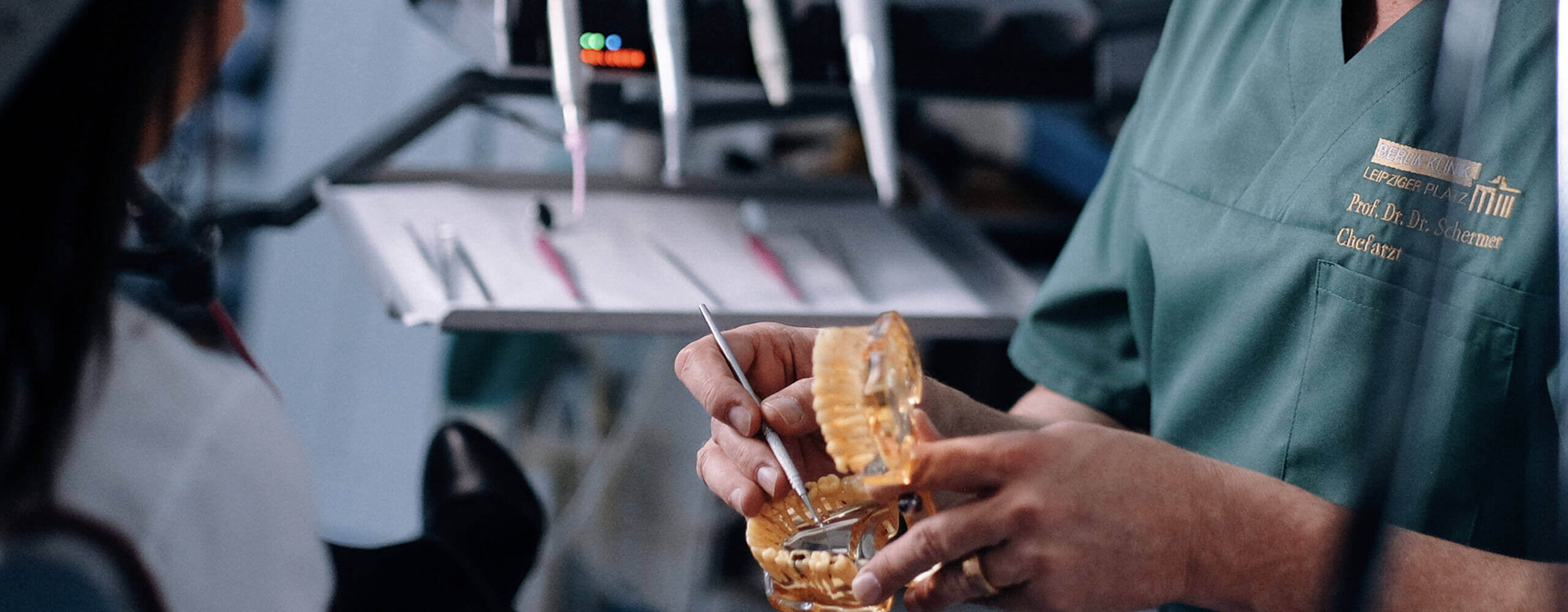

Gum Disease and Periodontics in Germany


Reasons for Jaw Bone Loss
There are many reasons for bone loss. The first is unhealthy gum. This means the bacteria around! The different bacteria in dental plaque and calculus, tartar are sitting around your teeth the whole day. They eat and destroy the bone and the periodont which fixes the teeth. The crap of the bacteria causes and provides inflammations like Gingivitis and Parodontitis which again provides further bone loss. And it is not reversible! Gingivitis which without treatment becomes a Periodontitis or periodontal desease is sometimes mistaken as gum disease which is only the start of the disease. Periodontics are the start of bone loss! If untreatened periodontitis will definitely end up in prosthetics or dentures. Dental bone loss by periodontitis is a very serious disease. Effects can very seriously harm other parts of the body! Many people think about dentistry that if it does not hurt they have no need to visit a dentist. Sometimes yes, but not in case of a periodontitis! Consequences of an unthreatened periodontitis may be severe. Not only you will loose teeth but it can also cause bad breath, halitosis up to breast implant inflammations and very serious heart and brain diseases.


Prevention of Bone Loss Is Sometimes so Easy
Notice: The most dramatic in immediate bone loss makes a tooth extraction. When a tooth is extracted without filling the extraction wound with bone or with bone replacement material, the jaw bone surrounding it will recede fast and for ever. Especially the fragile built upper jaw is hyper sensitive to tooth extractions without preventive reconstruction of defects. The defects heal themselve…but after you have lost massive amounts of bone height! Severely affected patients may have only a few millimetres of bone left, sometimes less than 10 per cent of their original jaw bone. The second most reason but widest spread reason for bone loss is periodontal disease. Gingivitis and Periodontitis in all its more or less aggressive and Therapie resistant expressions. Strong jaw bones are the foundation for healthy teeth and high quality dental prostheses. Hence, they are also significant for all related factors such as the longevity of teeth or implants, safety, and aesthetic aspects. Frequently it is the state of the jaw bones that determines the type of treatment a patient can receive. This is why in the past many patients received removable prostheses as a last resort. At BERLIN-KLINIK Periodontal Dep. we hope to offer fixed teeth or at least dental implants at the end of the treatment in Germany.
Individual Dental Prophylaxis
BERLIN-KLINIK Periodontal Department and BERLIN-KLINIK Prophylaxis programs: Professional individual care is the only secure way to stop periodontal diseases, periodontitis and bone loss. Basis is a serious and defined analysis and diagnostic of the reason and expression of each periodontitis and the commitment to consequent individual dental prophylaxis recall.
You Can Find Dental Implantology Special Topics Under:
BERLIN-KLINIK Periodontal Department and BERLIN-KLINIK Prophylaxis informs you about possible causes and treatment of periodontitis and can give you recommendations for dental home care. We offer you proven and successful therapies for all kinds of gum diseases and periodontal diseases in Germany. Gum diseases like the most common Gingivitis often involve diseases of the periodontium which are regularly followed up by Parodontitis which leads to bone loss. One of the most common oral diseases is periodontitis. It appears in a variety of forms and degrees of severity. Many people suffer from gingivitis or even periodontitis without seeking treatment or even being aware of it. What starts with seemingly harmless symptoms can lead to serious health conditions and tooth loss or loss of dental implants if left untreated. A simple check-up can help determine whether the periodontium or only the tissue surrounding the tooth and attaching it to the alveolar bone is affected. The severity and cause of the disease are then examined in a specialised laboratory. Untreated periodontitis and most of the periodontics also frequently causes the loss of healthy teeth or teeth worth preserving. The disease often manifests itself in bad breath and other afflictions, such as hypersensitive teeth and gums. A serious and consequent treatment at BERLIN-KLINIK Periodontology and BERLIN-KLINIK Prophylaxis can stop the progress. The treatment starts with intensive and sufficient laboratory diagnostics to define the type of illness. Followed by medication assisted intensive individual prophylaxis and goes on with surgical or non-surgical minimal invasive deep cleanings or root planning at individual recall intervals. If extensive gum treatment is required we can offer high frequency, laser and ozone therapy, alongside pain-free surgery under local or general anaesthetic. Maybe also a Treatment without the need of periodontal surgery. The interval varies on a case by case basis, but is usually every 3-6 months.
Normally, the gingivae are firm, tightly adapted to the teeth, and contoured to a point. Keratinized gingiva near the crowns is pink stippled tissue. This tissue should fill the entire space between the crowns. The gingiva farther from the crowns, called alveolar mucosa, is nonkeratinized, highly vascular, red, movable, and continuous with the buccal mucosa. A tongue depressor should express no blood or pus from normal gum, gingiva. Gingivitis means inflammation of the gingivae, causing bleeding with swelling, redness, exudate, a change of normal contours, and, occasionally, discomfort. Gingivitis the most common gingival problem, may evolve into periodontitis! Diagnosis is based on inspection. Treatment involves professional teeth cleaning and intensified home dental hygiene. Advanced cases may require antibiotics or surgical therapy. Simple gingivitis first causes a deepening of the sulcus, gingival crevice between the tooth and the gingiva, followed by a band of red, inflamed gingiva along one or more teeth, with swelling of the interdental papillae and easy bleeding. Pain is usually absent. It may resolve, remain superficial for years, or occasionally progress to Periodontitis.
To be true the most cases of gingivitis are caused by poor oral hygiene. Poor oral hygiene allows plaque to accumulate between the gingiva and the teeth; gingivitis does not occur in edentulous areas. Irritation due to plaque deepens the normal crevice between the tooth and gingiva, creating gingival pockets. These pockets contain bacteria that may cause both gingivitis parodontitis and root caries. Other local factors, such as malocclusion, dental calculus, food impaction, faulty dental restorations, and xerostomia, play a secondary but remarkable role as cofactors. Systemic provided forms of Gingivitis are definitely much more seldom than poor-hygiene provides Gingivitis! An uncontrolled diabetes may exaggerate the effects of gingival irritants, providing secondary infections and acute gingival abscesses common. In cases of leukemia, the gingivae maybecome engorged with a leukemic infiltrate, exhibiting clinical symptoms of edema, pain, and easily induced bleeding. In vitamin C deficiency (scurvy) the gingivae are inflamed, hyperplastic, and engorged, bleeding easily. Petechiae and ecchymoses may appear throughout the mouth. In pellagra niacin deficiency, the gingivae are inflamed, bleed easily, and are susceptible to secondary infection. Additionally, the lips are reddened and cracked, the mouth feels scalded, the tongue is smooth and bright red, and the tongue and mucosa may have ulcerations.
Gingivitis may be an early sign of a systemic disorder, particularly those that affect the response to infection, diabetes, AIDS, vitamin deficiency, leukopenia, particularly if it occurs in patients with minimal dental plaque. Some patients with Crohn’s disease have a cobblestone area of granulomatous gingival hypertrophy when intestinal flare-ups occur. Exposure to heavy metals like lead or bismuth may cause gingivitis and a dark line at the gingival margin. Severe deficiency of niacin or vitamin C can also cause gingivitis. Systemic causes of Gingivitis also commonly occurs at puberty, during menstruation and pregnancy, and at menopause, presumably because of hormonal changes. Similarly, oralcontraceptives may exacerbate inflammation.
describes a painful inflammation of the gingival flap over a partly erupted tooth, usually around mandibular 3rd molars (wisdom teeth). Infection is common, and an abscess may develop which then needs surgical treatment. Pericoronitis often recurs as food gets trapped beneath the flap which is not possible to clean by regular teeth cleaning . The gingival flap sometimes but not always disappears when the tooth is fully erupted.
Desquamative gingivitis may occur during menopause. It is characterized by deep red, painful gingival tissue that bleeds easily. Vesicles may precede desquamation. The gingivae are soft because the keratinized cells that resist abrasion by food particles are absent. A similar gingival lesion may be associated with pemphigus vulgaris, bullous pemphigoid, benign mucous membrane pemphigoid, or atrophic lichen planus. During pregnancy gingival swelling, especially of the interdental papillae, is likely to occur. Pedunculated gingival growths often arise in the interdental papillae during the 1st trimester, may persist throughout pregnancy, and may or may not subside after delivery. Pregnancy tumors are soft reddish masses that are, histologically, pyogenic granulomas. They develop rapidly and then remain static. An underlying irritant is common, such as calculus or a restoration with a rough margin.
Periodontitis is a serious infection of the dental periodontium””causing inflammation of the periodontal ligament, gingiva, cementum, and alveolar bone. It usually manifests as a worsening of gingivitis. Symptoms are rare except with HIV or when abscesses develop, in which case pain and swelling are common. Diagnosis is based on inspection, periodontal probing, and x-rays and labside testings to describe forms of anaerob bacteria. Treatment involves professional dental cleaning that extends under the gums and a strict professional prophylaxis and home hygiene regimen. Advanced and inflammatoric cases require antibiotics and surgical therapy. Symptoms and Signs of periodontitis are usually: Pain is often absent unless an acute infection forms in one or more periodontal pockets or if HIV-associated periodontitis is present. Impaction of food in the pockets can cause pain at meals. Abundant plaque along with redness, swelling, and exudate are characteristic. Gums may be tender and bleed easily, and breath may be foul.
Periodontitis usually develops when gingivitis, usually with abundant plaque and calculus beneath the gingival margin, has not been adequately treated for a longer time. In periodontitis, the deep pockets can harbor anaerobic organisms that do more damage than those usually present in simple gingivitis. The gingiva progressively loses its attachment to the teeth, periodontal pockets deepen, and bone loss begins. With progressive bone loss, teeth may loosen, and gingiva recedes. Tooth migration is common in later stages. Systemic causes of periodontitis and gum diseases are more seldom than the local forms. Systemic diseases that predispose patients to periodontitis include diabetes, especially type 1 diabetes; acquired, familial, and cyclic neutropenia, leukemia, lazy leukocyte syndrome, leukocyte adhesion deficiency syndromes, Papillon-Lefèvre syndrome, Down syndrome, Crohn’s disease; histiocytosis syndromes, agranulocytosis, infantile genetic agranulocytosis, hypo-gammaglobulinemia, Chédiak-Higashi syndrome, glycogen storage diseases, Ehlers-Danlos syndrome types IV and VIII, vitamin C deficiency, and hypophosphatasia. Caution: Faulty occlusion, causing an excessive functional load on teeth or insufficient under-dimensioned prosthetics or implant-prosthetics may contribute to progression of a particular type of periodontitis characterized by angular bony defects.
Periodontitis is usually chronic and characterized by periods of exacerbation and remission. Chronic periodontitis, formerly adult periodontitis occurs in localized and generalized forms, and people with significant disease tend to be > 30 years. About 80% of the population is affected to a mild degree, but the most advanced and rapid destructive cases are seen in less than 5% of the population.
Several more rapidly progressive subtypes of chronic periodontitis exist, collectively known as aggressive periodontitis. Aggressive periodontitis may develop as early as childhood, sometimes before age 3 years. Patients may have severe bone loss, even tooth loss, by age of 20. Neutrophil function may be defective in aggressive periodontitis. Its clinical significance is unknown. In one type of aggressive periodontitis that occurs in healthy adolescents, formerly called localized juvenile periodontitis, patients often have significant colonization of anaerobic AAC Actinobacillus actinomycetemcomitans. Typically, the signs of inflammation are minor. The disease is detected by periodontal probing or x-rays, which show localized, deep vertical bone loss, commonly limited to the 1st molars and incisors. Bone loss progresses much faster than in adult periodontitis, often at a rate of 3 to 4 ?m/day! An uncommon type of aggressive periodontitis formerly called prepubertal periodontitis affects deciduous teeth, usually shortly after eruption. Generalized acute proliferative gingivitis and rapid alveolar bone destruction are its hallmarks. Patients also have frequent bouts of otitis media and are usually diagnosed by age 4 years. In some patients, the disease resolves before the permanent teeth erupt. Treatment regimens are under study.
Prototypical aggressive periodontitis formerly called rapidly progressive periodontitis occurs in patients aged 20 to 35 years. It is often associated with so called periodontitis-marker bacteria as destructive anaerobic AAC actinomycetemcomitans, Porphyromonas gingivalis, Eikenella corrodens, and many gram-negative bacilli, but cause and effect are not clear. Some cases result from undiagnosed localized juvenile periodontitis or prepubertal periodontitis, but others appear independently. HIV-associated periodontitis is a particularly virulent, also rapidly progressing disease. Clinically, it resembles acute necrotizing ulcerative gingivitis (ANUG) combined with rapidly progressive periodontitis. Patients may lose 9 to 12 mm of attachment in as little as 6 month.
The basis of every treatment is the right diagnostics and analysis of the problem. BERLIN-KLINIK Periodontology is specialized in periodontal diagnostics and treatment. First the depth of gum pockets were checked. 4mm iss at risk and more than 7mm is a high risk depth! A gum pocket then also means a bone pocket. Which is definitely a serious problem for the treatment. With individually specialized periodontal tests which may be a polymerase chain record (PCR) test in the meaning of polymerase-chain-reaction to show aggressive bacteria types or a active matrix-metallproteinase test (aMMP-8). These are needed for basic diagnostics to effectively plan the following treatment steps. The periodontal test reports guide the way for further periodontal measurements. Clinical evaluation, dental x-rays, inspection of the teeth and gingiva combined with probing of the pockets and measurement of their depth are usually sufficient for diagnosis. One of the most important diagnostic procedures to lead the right way oh therapy is the labside done testing of forms of anaerobe bacteria, the PCR „Polymerase Chain Reaction” which in BERLIN-KLINIK Periodontal Department is done regularly to find out about the most efficient therapy ways. Also the or a active matrix-metallproteinase test (aMMP-8) to find out early about inflammatory reactions in tissues. Take care: pockets deeper than 4 mm indicate periodontitis! Dental x-rays reveal alveolar bone loss adjacent to the periodontal pockets.
When a tooth lost a certain amount of bone it is deemed periodontal hopeless. Hopeless teeth need to be extracted. Patients often think that because the tooth does not hurt, they do not understand why it needs to be extracted. The reason is that because the tooth is then impossible to clean. And with the extensive bone loss in one region, the bone loss may continue to other regions if not effectively treated. The problem with continuing and ongoing bone loss is that it makes a successful treatment very difficult and sometimes impossible. In some states of periodontitis and bone loss it is better to controlled pull the tooth out and find enough bone left to place an implant. Waiting for more years can cause so much bone loss that there will not be enough bone to set an implant without bone reconstruction. Even an old fashioned denture placed right time may fit very well versus one placed in years after losing more bone may move around and is not to become stable anyhow. And by moving around it destroys even more bone with its movements.
An infection of the bone around an implant is called Periimplantitis. Periimplantitis is a very serious and difficult to treat illness that can potentially lead to the loss of implants. There are many different factors that might lead to periimplantitis. Periimplantitis definitely needs treatment and definitely needs a strict professional oral hygiene regimen. In the following, the most important co-factors that can lead to damage or loss of implant provisitions are presented: Insufficient Oral Hygience level often leads to Periimplantitis. It needs a data collection for serious periimplantitis diagnostic, PCR-Diagnostic, aMMP-8 Probing, PZR and PZR-Recall with education of the patient are by now standard in implantology. Bacterial contamination happens particularly through the five to six standardised parodontal marker germs and gram- microorganisms. Osseointegrated implants are regularly surrounded by a microflora that is made of predominantly gram+ bacteria. Infectious implants are more often surrounded by gram bacteria, aMMP-8 testing. The oral hygiene level can be regulated through targeted education and training. Bad hygiene is enabling gingivitis and therefore parodontitis and periimplantitis, which can lead to further spread of other irritations of the periimplantary soft tissue and ultimately loss of hard tissue. Bone loss invariably leads to tooth loss and implant loss. Also important is Nicotine abuse.
One possible reason for a periimplantitis may be occlusal overstress: Missing and badly carried out functional diagnostic data collection or obstacles in its implementation lead to unfavourable occlusal appearance, pole strength, pole localisation as well as pole number. Be careful with so called Mother Theresa implant provisions!. Type and appearance of the dentures as well as number and static strength of dental implant constructions are of deciding importance in the deflection degree that the functional forces are leading over the structure into the implant. Mostly the overstress should have been prevented with a anatomical correct number of implants and a stronger statical construction. These influence therefore the pump effect and the way the forces are inserted into the sensitive periimplantary part. Periimplantitis caused to insufficient supoptimal implant design is a very significant technical reason as we found out. Implant systems and implant localisation, implant design as well as type and execution of dentures are important. The different one- and two-part (three-part) systems differ qualitatively in material, surface, radius, fit, size of the microfissure as well as in the insertion procedure itself. As mentioned before also strength of the pole, pole localisation and the number of poles play an important role. A technical key point is that besides a tube-in-tube design, the microfissure between abutment and inserted implant has to be as small and as tight as possible.
OP-Trauma and the way of Insertion may also cause a implant surrounding inflammation: “Minimally invasive” should always be a basic cornerstone of implantology. This means that a favourable relation between operation duration and instrument trauma have to be created in the respective hard tissue areas. This is best if visible! This does not mean transgingivial procedure! Transgingival procedure is not serious surgery. It was an invention of dental industry to sell more implants even to dentists who have not the qualification and the practice for serious implant operations.
Without good and effective oral hygiene the bone loss wil not be to control. Additional negative progress comes from further factors and lifestyles. Smoking and tobacco definitely will make your periodontal disease progress faster. Along with all the other problems it causes, we are talking about twice to six times negative progress by smokers! Not to talk about the increasing risk of oral cancer. Diabetes and periodontal disease have been linke, and if one is uncontrolled it can negatively affect the other. Uncontrolled dental bone loss will make diabetes more difficult to control and vice versa. Like diabetes above, periodontal disease has been linked to cardiovascular disease and as above, getting dental bone loss under control can help prevent cardiovascular health as well. Ostheoporosis and several medications have also to be considered in diagnostics and treatment.
Periodontal surgery can be very beneficial, but unfortunately tends to be fairly painful post operatively. And it may also cause seemingly longer teeth. In general, it is not the first course of treatment of dental bone loss, but may be needed if other treatments do not satisfy with results. Osseous surgery must be done when patients have severe dental bone loss, and is done to decrease the bone pockets around the teeth. This allows patients to clean more effectively around the gums. When there are massive gum recessions or thin tissue sometimes it is necessary to graft tissue over the particular area. Often the tissue is taken from the roof of the mouth and grafted to the particular area it is needed. Gingivectomie operation may be necessary as part of periodontal surgery and treatment which includes the removal or recontouring of bone. Gingivectomy means that only the gum tissue is removed or recontoured. This can be done with a conventional blade or using specialized therapy laser or modern high-frequency electrosurgery which we prefer in BERLIN-KLINIK Periodontics Germany Department. Depending on its anatomy the lingual frenulum can severely limit the action of the tongue and may need to be cut surgically. This is called a lingual frenectomy. Sometimes a frenectomy is needed at the midline of the upper or lower lips as well. On the upper lip sometimes it cause a gap called diastema between the two front teeth which is not by definition a functional problem but maybe negative for the sound of speech. And it makes one look kind of dumb.
Having done more than some thousands of bone reconstruction operations the head surgeon of BERLIN-KLINIK International Hospital in Germany Dr. Dr. Schermer, as one of international leading experts in alloplastic surgery, bone reconstruction and implantology, has a lot of experience with approved methods. If you would like to find out more about this topic there are various publications you can refer to. Dental defects that are not too serious can be treated in a minimally invasive and safe way, using bone replacement material. Surgery involving synthetic bone is called alloplastic surgery and is a specialised discipline of transplant surgery. BERLIN-KLINIK international Hospital and dental Clinic is very committed to this topic and gives regular scientific reports and presentations at national and international conventions and expert meetings. BERLIN-KLINIK also tries to make it available to all interested audiences through publication. Prof. Dr. Dr. Stefan Schermer is a senior lecturer in the field of bone reconstruction and also recognised by state authority for the further training of dentists and surgeons in this field.
